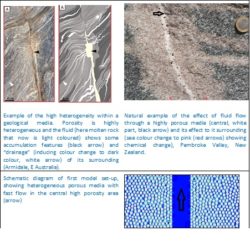Flow and Transport in heterogeneous Porous Media: Improving the safety of nuclear waste repositories and fundamental understanding of the chemical evolution of Earth
- Academic lead
- Sandra Piazolo (Earth and Environment)
- Industrial lead
- Richard, Metcalfe, Quintessa
- Co-supervisor(s)
- Mark Wilson (Mechanical Engineering), Thomas Mueller (Earth and Environment)
- Project themes
- Environmental Flows, Geophysical flows, Microflows & heat transfer, Reacting flows, mixing and safety
Our ability to confidently predict the safety of a nuclear waste repository depends on our ability to correctly model the interaction of fluids residing in the host rock surrounding the repository and the potential for fluid flow to bring radionuclei from the repository to the biosphere. At the same time, a very similar problem occurs at depth in the Earth crust where fluid, this time molten rock and not aqueous fluid, flows through a highly heterogeneous porous media which is saturated in fluid as well. The most commonly applied simulations of fluid in heterogeneous geological porous media are quite simplistic usually described by Darcy’s law. This is a good approximation for viscous flow conditions at homogeneous conditions, however in natural geological formations, heterogeneity exists at every scale. These heterogeneities lead to non-Gaussian multiscale velocity field distributions. Hence, the assumptions may be seriously misleading.
The exploration of the influence of a highly heterogeneous porous media on its fluid flow dynamics and transport of chemicals is an exciting research opportunity, which would be addressed in this PhD project.
The central aim will be to explore in fundamental terms the effect of a heterogeneous porous media on fluid dynamics at a range of geologically meaningful boundary conditions. The work undertaken will, thus clearly assess the situations for which heterogeneities impact large scale fluid fluxes and elemental transport. The focus would be to develop and analyse mathematical and numerical models that incorporate heterogeneities at a range of scales and spatial distribution and their implications. The project would begin with idealised configurations (e.g. one low porosity channel in a less porous medium), and move towards observational interpretation of geological data and inversion methods. The specific focus can depend on the student’s personal interest.

